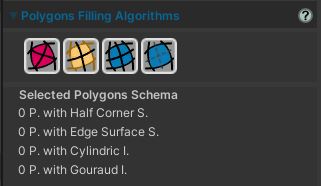Curved Poly
Intro
General Features
version 1.3 News
about the Shadow Framework
Setup
How to Start
Editor Interface
Editor Windows
Tools Sets
Assets
Assets Worflow
Game Objects
Assets Upgrade to 1.3
Common Tools
Selection
Hiding and Visibility
Parts List
Shape Tools
Selection Transform
Backgrounds
Handles and Edges
Polygons
Shaping Options
Tessellation
LoDs Assets
Hints (A to P)
Composition Tools
Primitives
Custom Parts
Compositing
Materials Tools
Unwraps Tools
UV Panel
Advanced Shape Tools
Shape Edit Tools
Shapes Customization
Cutting and Splitting
Making Shapes
Exploiting other Tools
Issues and Fixing
Curves and Surfaces
Free Paths
Parametric Curves
Generating Surfaces
Update Surfaces
Polygons

Fig. 1 Polygons Filling Algorithms
Let's say we have selected at least one polygon. The dedicated
inspector here may have a section called Polygons Filling Algorithm. This depends upon
the Selection Mode in use: to have the section you need to be either in ![]() Polygons Mode, or
Polygons Mode, or ![]() Parts
Mode or
Parts
Mode or ![]() Rings
Mode. This sections controls how real polygons are generated inside curved polygons.
Rings
Mode. This sections controls how real polygons are generated inside curved polygons.
There are more ways Curved Poly can use to fill a curved polygon with a proper set of raw polygons (i.e. triangles). Each way is a specific procedure we call Filling Algorithm (or also Interpolation Algorithm or Interpolation Schema). Since they change the way each specific Curved Polygon appears, it's possible to use different Filling Algorithm on different curved polygons. You can select any group of Curved Polygons here, and click on one of the buttons to try out a different procedure for each curved polygon which doesn't look the way you want it to look.
How to Use this: you can select any group of Curved Polygons here, and click on one of the buttons to try out a different Filling Algorithm Tip: there is a lot of work around Filling Algorithms at MushroomsLabs. We literally researching on more and more alternatives to do this. You may find new alternative algorithms in newer version of Curved Poly, each one improving the way polygons are shaped. Version 1.2 introduced a new algorithm called Half Corner Surface, we are planning to introduce a better one we are working on in one of the 1.3.x![]() Half-Corner
Schema: this is a very complex interpolation schema, generating wonderfull polygons in
most of the cases. Since version 1.3, it's the default choice for every new model generated with Curved Poly Maker. It's not perfect, but slightly better than Edge
Surface Schema, and slightly slower. In most of the cases, you should not see a bit difference,
but if something looks wrong with this schema, you should switch to one of the others.
Half-Corner
Schema: this is a very complex interpolation schema, generating wonderfull polygons in
most of the cases. Since version 1.3, it's the default choice for every new model generated with Curved Poly Maker. It's not perfect, but slightly better than Edge
Surface Schema, and slightly slower. In most of the cases, you should not see a bit difference,
but if something looks wrong with this schema, you should switch to one of the others.
![]() Edge
Surface Schema: this is a very complex interpolation schema, generating wonderfull polygons
in most of the case. If the edges pattern is too complex, this may generate some strange behaviour.
Edge
Surface Schema: this is a very complex interpolation schema, generating wonderfull polygons
in most of the case. If the edges pattern is too complex, this may generate some strange behaviour.
![]() Cylindric
Interpolation: this is a fast one and works perfectly in situations where edges across
vertices satisfy some specific constraints (you need to have 4 edges on a corner, and opposite handles must be aligned; this is the case of almost all primitives of Curved Poly - Shape Editor). Cylindric
Interpolation ignores Edges Editing Normals. Also, this is the reccommended algorithm
in case you have very little polygons or polygons with a very low Level of Details or low Tessellation Hints.
Cylindric
Interpolation: this is a fast one and works perfectly in situations where edges across
vertices satisfy some specific constraints (you need to have 4 edges on a corner, and opposite handles must be aligned; this is the case of almost all primitives of Curved Poly - Shape Editor). Cylindric
Interpolation ignores Edges Editing Normals. Also, this is the reccommended algorithm
in case you have very little polygons or polygons with a very low Level of Details or low Tessellation Hints.
![]() Gouraud
Interpolation: same as Cylindric Interpolation, but the way normals are computed
is more simple
Gouraud
Interpolation: same as Cylindric Interpolation, but the way normals are computed
is more simple
<< Prev Next >>